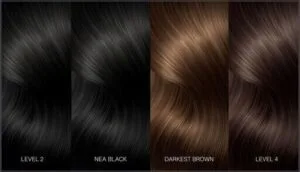This site is supported by our readers. We may earn a commission, at no cost to you, if you purchase through links.
You’ve probably heard a colorist say something like “you’re a level 6” and wondered what that meant. Hair levels are the foundation of color work—a numbered scale from 1 to 10 that measures how light or dark your hair is. Think of it as the universal language that lets colorists worldwide understand exactly where your hair sits on the spectrum, from jet black to pale blonde.
Without knowing your starting level, choosing the right dye or predicting how your hair will lift becomes guesswork. This system takes the mystery out of color decisions and helps you avoid those disappointing results where the box and the mirror don’t match.
Table Of Contents
- Key Takeaways
- What Are Hair Levels?
- The Hair Level Scale Explained
- How to Determine Your Hair Level
- Factors Affecting Hair Level Assessment
- Hair Level and Hair Color Choice
- The Role of Hair Tone and Undertone
- Achieving Desired Hair Color Results
- Professional Hair Color Consultation
- Hair Color Maintenance by Level
- Preventing Damage When Changing Levels
- Frequently Asked Questions (FAQs)
- Conclusion
Key Takeaways
- Hair levels run from 1 (jet black) to 10 (platinum blonde) and give you and your colorist a shared language for figuring out what colors you can realistically achieve based on where you’re starting.
- You can safely shift two to three levels in one session without wrecking your hair—bigger jumps require multiple appointments and proper care to avoid damage like breakage or fried ends.
- Natural light shows your true hair level better than indoor lighting, and converting a photo to black-and-white cuts through tones so you can accurately match your depth to a level chart.
- Dark hair holds color longer but still needs sulfate-free products and UV protection, while lightened hair loses moisture fast and requires purple or blue toners, weekly masks, and touch-ups every 4-6 weeks to stay vibrant.
What Are Hair Levels?
If you’ve ever sat in a salon chair wondering why your colorist keeps mentioning numbers, you’re not alone. Hair levels are the secret language that beauty professionals use to describe how light or dark your hair is.
Let’s break down what this numbering system means and why it matters for your next color appointment.
Definition of Hair Levels
When you’re sitting in the salon chair, hair levels are your roadmap. They measure how light or dark your hair is on a scale from 1 to 10. Level 1 is the deepest black, while level 10 is platinum blonde.
This hair color level system gives you and your stylist a common language for understanding color depth analysis and achieving your dream shade. Knowing your hair level helps determine the achievable color range for dyeing or bleaching.
The Universal Level System
Your hair color level system didn’t start by accident—it’s built on decades of professional utility and system origins. Colorists worldwide rely on this standardized color classification to speak the same language, whether you’re in New York or Tokyo.
From Hair Level 1’s deepest black to Hair Level 10’s platinum, this structure ensures everyone’s on the same page about your hair’s depth. The system uses lightness and darkness to classify hair color.
Hair Level Chart Overview
Now that you understand the universal system, you’ll want to see how it works in practice. A hair color chart gives you a visual roadmap of what each level looks like:
- Hair Level 1 displays deepest black tones
- Hair Level 10 shows platinum blonde shades
- Chart standardization ensures level accuracy worldwide
- Digital integration improves at-home color selection
- Colorimetry parameters measure lightness precisely
This visual tool makes choosing your next shade straightforward.
The Hair Level Scale Explained
Now that you understand what hair levels are, let’s break down the actual scale.
The system divides into three main groups based on how light or dark the hair is. Each range gives you a clear picture of where your hair sits and what colors you can realistically achieve.
Levels 1-4: Dark Shades
The darkest end of the hair color levels spectrum holds the deepest shades. Hair Level 1 is true black, reflecting zero light, while Hair Level 2 shows subtle warmth. Hair Level 3 is the darkest brown, and Hair Level 4 reaches chocolate territory.
These Dark Hairtones, rich in Eumelanin Content, present Lightening Challenges but enjoy Global Popularity. Proper Color Maintenance preserves their depth.
Levels 5-7: Medium Shades
Right in the middle of the hair color levels chart, you’ll find Hair Level 5 (medium brown), Hair Level 6 (dark blonde), and Hair Level 7 (medium blonde). This Adaptable Base range offers serious Color Adaptability—you can go warmer or cooler without much fuss.
Their Demographic Prevalence is notable in lighter-haired populations, and Tone Influence really shines here. Maintenance Needs? Manageable compared to lighter shades.
Levels 8-10: Lightest Shades
At the top of the scale sit the lightest blonde shades—your gateway to Platinum blonde territory. Here’s what you need to know:
- Hair Level 8 (Light Blonde) shows pale yellow tones
- Hair Level 9 appears almost platinum
- Hair Level 10 is pure Platinum blonde
- The Lightening Process requires careful Damage Prevention
Toning Solutions and diligent Color Maintenance keep these shades looking their best.
How to Determine Your Hair Level
Figuring out your hair level doesn’t require a trip to the salon, though a professional can always confirm what you’re seeing.
You can assess your hair’s depth at home using a few straightforward methods that work for most people.
Here are three practical ways to determine where your hair falls on the level scale.
Assessing Hair in Natural Light
Determining hair color level starts with the right light source accuracy. Natural light reveals your hair’s true depth without the tricks indoor lighting plays on your eyes. Step outside or near a window on a cloudy day—indirect sunlight benefits your assessment by reducing glare. Hold a small section of hair away from your scalp. Photograph color analysis helps too: snap a pic and convert it to black-and-white to see depth clearly. Hair type challenges like highlights or gray strands mean you’ll need to check multiple sections. Professional recommendations emphasize this step because understanding hair color levels in natural light prevents color mishaps. Your eyes need honest lighting to see what’s really there.
| Lighting Type | Effect on Hair Color | Best For Assessment |
|---|---|---|
| Natural Light (Cloudy) | Shows true color depth | ✓ Ideal |
| Indoor Fluorescent | Adds cool/green tones | ✗ Avoid |
| Direct Sunlight | Exaggerates warm tones | ✗ Avoid |
Using a Hair Level Chart
A level chart acts like your color roadmap—it shows you where you’re and where you can realistically go. Place your hair sample against the chart swatches for color matching accuracy.
Understanding hair color levels means spotting both depth and tone influence. This determines bleach planning needs and prevents chart limitations from derailing your hair color level goals.
The Black-and-White Photo Method
Can’t figure out if you’re a level 6 or 7? Try snapping a photo and converting it to grayscale—it cuts through tonal variations and lighting influence that throw off accuracy concerns.
Here’s how digital conversion helps with determining hair color level:
- Take a clear photo of your hair in natural light
- Convert the image to black and white using your phone
- Compare the grayscale result against a similarly converted hair color level system chart
This practical applications trick reveals your true depth.
Factors Affecting Hair Level Assessment
Figuring out your hair level isn’t always as straightforward as holding up a chart and picking a match. Several factors can throw off your assessment and lead you to the wrong conclusion about where your hair actually sits on the scale.
Let’s look at what can affect your ability to accurately determine your hair level.
Natural Vs. Colored Hair
Your natural hair and colored hair read differently when you’re trying to pin down hair levels. Natural hair contains up to 95% eumelanin, giving you a stable, unaltered color depth that’s easier to assess.
Colored hair, however, has a chemically altered composition and can appear lighter or darker depending on fade and color retention. This affects how accurately you can match your current level to a chart.
Lighting and Environment
Beyond whether your hair has been colored, lighting conditions play a huge role in accurate assessment. Natural daylight between 5000–6500K gives you the truest read on hair levels and color perception, while incandescent bulbs add warmth and fluorescents wash it out.
Environmental factors like light temperature directly shift how you see depth and tone, making understanding hair levels tricky under inconsistent conditions.
Professional Vs. At-Home Evaluation
Given how tricky lighting can be, you might wonder whether figuring out your hair color level at home is worth the hassle. Professional evaluation achieves up to 92% accuracy, while at-home assessment leads to incorrect level identification in 17–27% of cases.
That difference matters when determining hair color level, affecting everything from outcome satisfaction to damage potential and longevity results.
Hair Level and Hair Color Choice
Your current hair level isn’t just a number—it’s the starting point that determines what colors you can realistically achieve. Think of it like a roadmap: where you’re now shapes where you can go next.
Your current hair level is the starting point that determines what colors you can realistically achieve
Understanding this connection helps you make smarter choices, whether you’re reaching for a box of dye at the store or sitting in a salon chair.
Matching Color to Current Level
Understanding hair color levels makes all the difference when you’re choosing your next shade. Level matching errors cause over 80% of color problems, so you need to match dye within one to two levels of your starting point.
The hair color chart guides developer selection and undertone considerations, helping you avoid brassy tones while improving gray coverage and shade longevity.
Realistic Color Transformations
Your hair’s current level sets real boundaries for color transformations. You can safely shift two to three levels in one session without compromising hair integrity. If you’re at level 4 and dreaming of level 9, that’s a multi-appointment journey.
Americans color their hair four to five times yearly, and realistic expectations prevent damage. Gradual changes protect your strands, while the hair color chart maps achievable shades within level limitations.
Working With Box Dye Vs. Salon Color
Box dye costs run from $5 to $20, while salon color ranges from $50 to $300. However, professionals deliver custom shade customization based on your hair color levels that box formulas can’t match. Salon color longevity extends six to eight weeks compared to box dye’s three to four weeks.
Your hair stylist assesses damage rates and applies precise application techniques, whereas at-home kits cause uneven results 30% more often.
Key differences include:
- Colorist expertise prevents banding and unwanted tones
- Professional formulas reduce hair damage by 50%
- Custom mixing creates individual shades
- Salon treatments include conditioning additives
- Box dye often requires corrective appointments
The Role of Hair Tone and Undertone
Your hair level tells you how dark or light your hair is, but tone is what gives it personality. Tone is the warm, cool, or neutral cast that sits on top of your base level—think golden, ashy, or somewhere in between.
Understanding your hair’s undertone helps you choose colors that actually work with what you’ve got, instead of against it.
Identifying Hair Undertones
Think of hair undertones as the hidden colors beneath the surface—they’re what make or break your color results. To spot yours, try the white paper test in natural light: hold a sheet next to your strands. Yellow or peach tones signal warmth, while blue or pink lean cool. A strand test or color draping can reveal these pigments with over 90% accuracy before you commit.
| Test Method | What It Reveals |
|---|---|
| White paper in natural light | Yellow/peach = warm; blue/pink = cool |
| Strand test | Underlying pigments with 92% accuracy |
| Color draping | Undertone identification at 89% reliability |
| Lightening observation | Orange (levels 5-6), yellow (7-8), pale yellow (9-10) |
| Eye color analysis | Brown/amber = warm (81%); blue/green = cool (77%) |
Natural brunettes commonly show red or orange undertones in most cases, while blondes lean toward yellow-based tones. If you’ve colored your hair before, those treatments shift your natural undertones, making identification trickier. Processed hair requires reassessment since permanent color alters undertones greatly, and lightening reveals persistent warm pigments nearly every time.
Getting this right matters more than you’d think. Misidentified undertones are behind most color correction appointments and that “brassy” look after lightening. For extensions, incorrect undertone matching is the top reason they look fake rather than blended. Your skin undertone also plays a role—people with warm skin tones usually have yellow, orange, or red hair undertones.
Warm, Cool, and Neutral Tones
Once you know your undertones, you can decode the three tone families. Warm tones feature golden, copper, or honey pigments—think caramel highlights or chestnut brown. Cool tones lean ash, platinum, or icy with blue-violet bases. Neutral tones split the difference, blending both for maximum flexibility.
About 35-40% of 2025 trends favor warm shades, while cool tones claim 30%.
Choosing Complementary Colors
Complementary colors work like magic when you’re neutralizing brassiness or enhancing contrast. If you’ve got yellow tones at level 9, purple shampoos are your best friend. Orange showing through at level 6? Blue-based toners handle that.
The color wheel guides corrective coloring and fashion trends alike, while digital tools now match hair color levels to perfect complementary shades using uploaded photos.
Achieving Desired Hair Color Results
Getting the hair color you want isn’t about making drastic jumps overnight. Your current level, the techniques your stylist uses, and the condition of your hair all play a role in how your color turns out.
Here’s what you need to know to set realistic expectations and protect your hair along the way.
Gradual Level Changes
Your hair color level doesn’t change overnight. Pigmentation changes happen gradually due to age-related shifts, hormonal influence, and lifestyle factors. Moving from one level on the hair color chart to another takes time and patience.
That’s why hair health matters so much—healthier strands handle the shift better. Whether you’re hair lightening or going darker, expect the journey to unfold over several sessions.
Lightening and Darkening Techniques
Changing your hair lightening or hair darkening path depends on technique choice. Bleach damage can lift up to six tones on the level chart but weakens strands considerably. Balayage effects offer gentler two-tone lifts with natural dimension, while red shades like Cherry Cola blend color depth beautifully.
Darkening shampoos with polygonum benefits gradually restore pigment without harsh chemicals, protecting your hair’s integrity throughout transformation.
Importance of Hair Health in Coloring
No matter which coloring technique you choose, your hair’s current condition determines how well it holds onto pigment. Healthy strands absorb color evenly and resist fading, while damaged hair struggles with both. Professional application minimizes coloring chemical damage and extends color longevity through proper assessment.
Building Resilient Hair for Better Color:
- Nourish from within – protein-rich foods strengthen strands before transformation
- Deep condition weekly – restores moisture lost during chemical processes
- Protect daily – heat shields and gentle products maintain integrity between appointments
Preventative care protects your investment.
Professional Hair Color Consultation
Walking into a salon can feel overwhelming if you’re not sure how to explain what you want. A professional consultation takes the guesswork out of choosing the right color for your hair level and goals.
Here’s what makes working with a colorist worth it.
Benefits of Salon Assessment
A salon assessment gives you color precision you can’t get at home. Professional hair color services match your hair levels perfectly, and stylists spot undertones that matter for customization benefits.
You’ll see a confidence boost from colors that complement your skin. Plus, you avoid costly fixes, making it a smart cost efficiency move.
Your hair appointment protects hair health while delivering the look you want.
Communicating Hair Level and Goals
Once you’re at the salon, clear communication makes all the difference. Bring reference photos and explain your hair history—previous treatments, colors, everything matters.
Your stylist uses the hair color chart and their expertise to set realistic goals. Understanding hair color levels helps both of you speak the same language.
Visual communication bridges gaps, aligns client expectations with stylist expertise, and ensures consultation dynamics lead to results you’ll actually love.
Color Matching for Extensions
Extensions need the same care as your color consultation. Nearly half of extension users say color matching is everything—it’s what keeps your look natural.
Hair Color Maintenance by Level
Once you’ve got your hair at the level you want, keeping it there’s a whole different game. Dark hair and lightened hair need totally different care routines to stay vibrant and healthy.
Let’s break down what works best for your specific hair level.
Caring for Dark-Colored Hair
Dark brown and dark black hair levels hold color longer, but you still need to protect them from color fading. Wash less often to keep moisture balance intact. Choose sulfate-free products and UV protection sprays to shield your hair from sun damage.
Don’t forget scalp health—regular moisturizing helps your darker hair stay strong and vibrant between coloring sessions.
Maintaining Lightened Hair
Because bleached hair loses moisture fast, you need a focused plan. Understanding hair color levels tells you lightened strands need extra care. Here’s your maintenance routine:
- Wash 2-3 times weekly with sulfate-free shampoo to preserve natural oils
- Apply weekly hair masks with argan or coconut oil for hydration strategies
- Use heat protectant sprays before styling to support damage prevention
- Schedule salon touch-ups every 4-6 weeks for color upkeep
- Wear silk pillowcases and limit chlorine exposure for lifestyle impacts
Toning and Product Recommendations
After lightening, your toner level matching matters for controlling brassiness. Purple shampoo like Matrix So Silver neutralizes yellow tones in blonde hair, while blue formulas tackle orange undertones.
Professional toner types—permanent creams or demi-permanent gels—last about 20 shampoos in salons. At-home toning works for maintenance between visits, though product application guidelines stress timing to avoid muddy results.
Preventing Damage When Changing Levels
Changing your hair color can be exciting, but it also puts stress on your hair. If you’re not careful, you can end up with damage like breakage, dryness, or fried ends.
Here are the most important steps to protect your hair during the process.
Minimizing Chemical Damage
When you’re jumping between hair color levels, think of chemicals like a double-edged sword—they transform your look but can weaken your strands. Understanding hair color levels helps you plan smarter changes. Here’s how to protect your hair:
- Use sulfate-free shampoos to keep natural oils intact
- Apply bond-repairing products like Olaplex to rebuild broken proteins
- Adopt protective styling to reduce breakage on fragile, chemically-treated hair
Heat and UV Protection
After changing hair color levels, your strands face threats beyond chemicals. Heat damage starts around 365°F but turns permanent above 392°F on dry hair. UV rays penetrate your cuticle, breaking down proteins and fading color—blondes are especially vulnerable.
Use heat protectants that form protective films and products with UV filters. Understanding hair color levels means protecting your investment from heat styling and sun exposure daily.
Regular Trims and Hair Treatments
Split ends climb your hair shaft like cracks in a windshield—regular trims every 6-8 weeks stop them cold.
Treatment impact matters too: keratin and protein treatments reduce breakage while strengthening damaged strands for up to 6 months.
Understanding hair color levels means protecting your work through damage prevention, not just choosing the right shade during color transformations.
Frequently Asked Questions (FAQs)
How does hair porosity affect color results?
Your hair’s ability to “drink up” color depends on porosity. High porosity hair grabs color fast but fades quicker, while low porosity resists absorption, affecting color depth, vibrancy, and longevity.
Can medications change your natural hair level?
Yes, certain medications can alter your natural hair pigmentation through melanocyte interference and drug-induced depigmentation. Chemotherapy drugs and tyrosine kinase inhibitors are most commonly linked to these reversible pigmentation shifts through medication interactions.
Do hair levels differ by ethnicity or race?
Natural melanin production varies by ethnicity, affecting baseline hair levels. Most people worldwide have darker hair (Levels 1-4), while lighter shades are more common in Northern European populations due to genetic predispositions.
What causes hair to lighten naturally over time?
Your hair lightens naturally over time due to UV exposure, melanin reduction with age, oxidative stress, genetic factors, and environmental impact.
These processes break down hair pigmentation, causing hair color fading.
How often should you reassess your hair level?
You should reassess every 4-6 weeks, depending on dye types and regrowth visibility. Color fading, hair health, and maintenance practices influence timing.
Professional evaluation ensures an accurate understanding of hair color levels and prevents damage.
Conclusion
Think of hair levels as your color compass—without it, you’re moving blind. Now that you understand this numbered system, you can walk into any salon speaking the same language as your colorist, set realistic expectations, and avoid those box-dye disasters.
Whether you’re lifting from a level 5 or maintaining a level 9, you’ve got the knowledge to make smarter decisions. Your hair transformation starts with knowing exactly where you stand.















